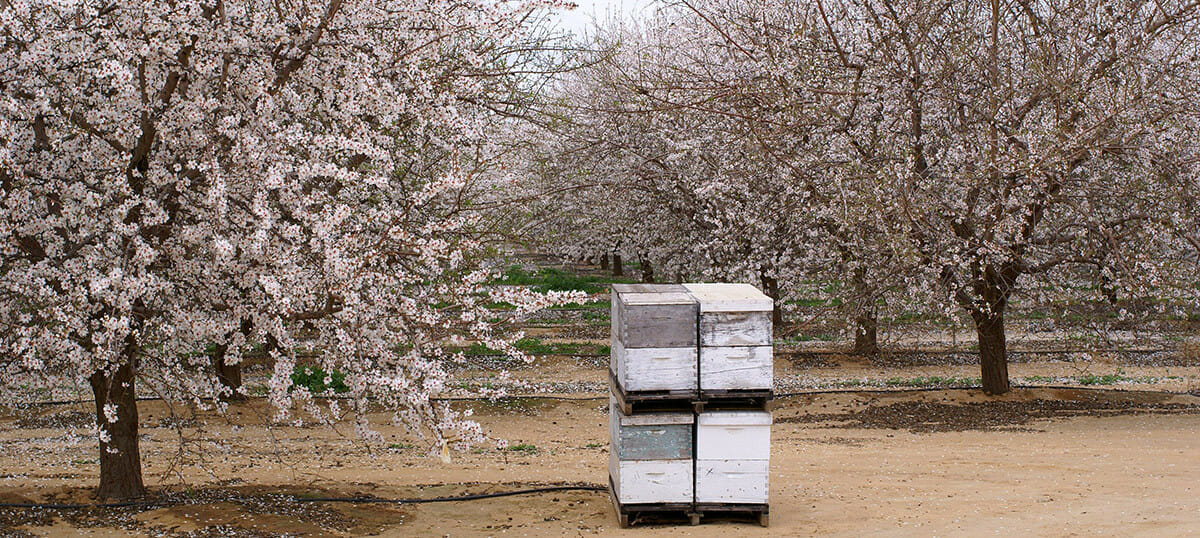Every year, almond growers spend about $290 million on pollination services, hiring hives from beekeepers across the country. Though some almond varieties can self-pollinate, the majority require a bee to pollinate every individual flower in order to transform it from delicate petals into the kernel we love to eat. The almond market may be doing […]

Every year, almond growers spend about $290 million on pollination services, hiring hives from beekeepers across the country. Though some almond varieties can self-pollinate, the majority require a bee to pollinate every individual flower in order to transform it from delicate petals into the kernel we love to eat.
The almond market may be doing well (there was a 220 percent increase in consumption between 2005 and 2012), but both the cost of pollination services and the uncertainty that there will be enough hives to go around has been turning some growers into beekeepers.
Almond grower Ryan Cosyns bought his first bees in 2005, though his family had been farming almonds since the early 1970s. “Bees at the time had a lot of problems,” says Cosyns, referring to issues like Colony Collapse Disorder. “A lot of beekeepers didn’t know how bad their losses were until January,” he adds. This left his family scrambling to find extra hives to pollinate their 1,000 acres of almonds, an orchard that requires bees from about 2,000 colonies to make the rounds. “We wanted to secure our own supply and secure the quality of the hives,” says Cosyns.
Luckily, Cosyns discovered a beekeeper in a nearby town who wanted to sell his business. It had everything from the hives to trucks to forklifts, and even seasoned employees. Though Cosyns had worked with beekeepers for decades, he’d never kept his own hives, much less thousands of them. He says that if the employees hadn’t stayed through the transition, he would have never bought the business. “I educated myself enough to know that we needed people who knew what they were doing and could teach me what to do,” he reveals.
Caring for a couple of hives is a simple backyard hobby, but the only way to do it on the scale most almond growers need is to make it a full-time business. “It takes a bit of management and time and focus,” says Bob Curtis, associate director of agricultural affairs at the Almond Board of California. He notes that there’s more interest in becoming vertically integrated, especially in the form of almond growers getting into beekeeping, “but they should realize that it’s not a lighthearted business to get into.”
If one of these hybrid beekeepers fails, it’s likely it was because he treated it as an easy way to save some money. Cosyns has seen many growers decide it’s “easier to just write the check for the rental” after trying their hand at beekeeping. “[Failed beekeepers] think they can have their hives and feedlot them through the summer,” Cosyns says, referring to the practice of leaving bees in one place with only one source of food to nourish them. It’s the pollinator equivalent of factory farming.
This has even kept some out-of-state beekeepers from selling pollination services to California almond growers, despite the lucrative returns. “Growers think the bee prices are so high that every beekeeper in the country must want to come to California, but it’s just not true,” Cosyns says. “They don’t want to send their bees into ‘the cesspool of beekeeping,’ as they call it.”
Natural water sources have run dry and natural forage has withered away, leaving large monocultures as the only food source. Once the bloom is over, Central California becomes a food desert again for bees. And disease runs rampant in the almond groves. “Any disease you have, or the neighboring beekeeper has, will transfer,” Cosyns adds. Even with careful hive management, areas can become oversaturated with pollinators during the short bloom season. Between the drought in California, which has been slowly chipping away at farmers’ orchard sizes and the influx of bees after the almond harvest each year, there isn’t always enough food to go around.
Without growers like Cosyns handling and housing local bees for pollination services, eventually there may not be enough to go around. In China, a lack of bees has led to the practice of hand-pollination becoming somewhat common – if not totally economical. Using bees is eight times cheaper than paying humans to do the same work. Taking the size of the California almond industry into account, that scale of hand-pollination is essentially impossible.
California’s largest almond grower, Paramount Farming Company, has also moved into beekeeping to ensure that there’s enough pollinators to go around. “The population of bees hasn’t been maintained, it’s been declining,” says Sean Alibrando, senior manager of Wonderful Bees, Paramount’s beekeeping division. “We feel like we benefit a lot from those little guys and we need to help save the bees as well.” Though Paramount Farming Company grows 75,000 acres of almonds and pistachios, compared to Cosyns’ 1,000 acres of almonds, Paramount also purchased a pollination company to help make the switch. Wonderful Bees may keep Paramount Farm’s pollination needs at the top of their list, but the company will also be renting its services to other growers. “This whole project doesn’t work if you don’t make money the rest of the year,” Alibrando says, adding, “You have to move them to better forage anyway – you might as well make some money while you’re doing that.”
While it seems likely that this trend will continue for California almond growers, the intensive nature of the work will keep part-timers from jumping on board. “I certainly don’t want to tell every grower ‘you can do it,’” Cosyns says. “But the demand for hives isn’t going away anytime soon.”
Correction: The story has been changed to reflect the correct name of Paramount Farming Company and correct amount of acres of almonds and pistachios they grow. We regret the errors.